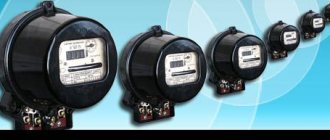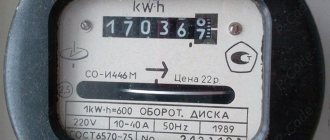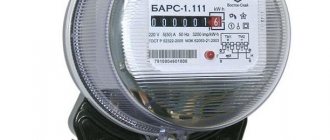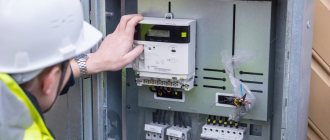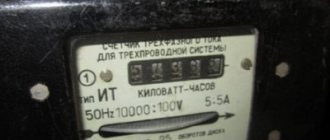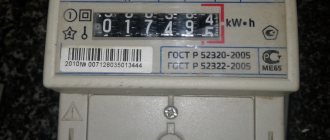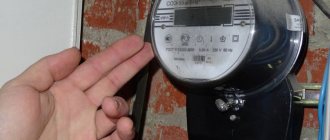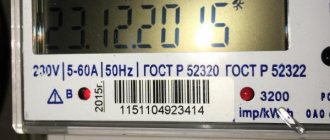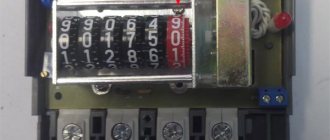Which electric meter should I choose for outdoor installation?
There are household electricity meters designed for installation outside the home. They are able to withstand fluctuations in air temperature while maintaining accurate readings.
The devices are single- and multi-tariff, single- or three-phase.
Street meters come in different capacities.
To determine it, you need to calculate the total power of all electrical appliances in the room. If it is below 10 kW, then a 60 A meter is suitable, if more - 100 A. The accuracy class must be at least 2.0.
Devices are now being produced that work well even at low temperatures.
When purchasing an installation box, you need to pay special attention to its tightness. Heating is not required
The moisture-resistant box must have a degree of protection of at least IP53-IP54.
The box should be selected taking into account the design of the meter.
It is necessary to have a window on the door to take readings.
As an outdoor option, a single-phase electric meter is most suitable - for a small house and cottage, or a three-phase one - for a multi-storey cottage with a swimming pool, sauna, etc.
In the latter case, the main thing is to correctly connect the device and evenly distribute the load on the network circuits.
Electric meters have a higher accuracy class than induction meters. The readings remain stable despite temperature changes throughout the entire service life.
When selecting the type of device mounting, it is better to give preference to a DIN rail. It is universal.
Before purchasing, you need to pay attention to the seal and the date of the last verification. Its age should not exceed two years - for single-phase devices and 1 year - for three-phase
What you should know before installing the device
Based on the principle of operation, meters are divided into electronic and induction. Induction energy metering devices are less accurate and are being widely replaced with electronic ones. Before purchasing, it is necessary to inspect the integrity of the government seal and specify the deadline for installing the seal on the device. If the meter is three-phase, then the installation of a seal on the electric meter must be done no later than 1 year, for a single-phase device - no more than 2 years.
Any electrician can install the meter, but before work it is necessary to request from the energy sales company a standard contract for the performance of work with a statement of division of balance sheet attached to it. The documents will contain all the requirements for installing an electricity meter, and will describe the boundaries of responsibility of the electricity supplier and the owner of the property.
Installation procedure
You are allowed to install the meter yourself, but a representative of the resource supplier must connect the device. The work is performed in the following order:
- the input line is de-energized;
- A circuit breaker is installed in front of the device, and an electric meter is connected after it;
- to ensure safe operation of electrical equipment, grounding is installed;
- The home electrical wiring is connected to the output contacts of the product.
When carrying out work, the current regulations must be observed. When the device is mounted and connected, it is subject to sealing and registration.
After installation, a test run is carried out to check that the connection is working properly. Installation and connection are carried out in strict accordance with the requirements of safety regulations.
Payment Features
The consumer must pay for the installation of the electricity meter. The cost of installation and connection of an electric meter is from 1 to 5 thousand rubles, depending on the product model. A single-phase, single-tariff device will cost less than an electronic three-phase device, which takes into account indicators for several tariffs.
The owner must resolve the issue of placement of the electricity meter with the resource supplier. The latter does not have the right to force the consumer to move the device outside, but the owner is obliged to ensure unhindered access for employees of the monitoring organization to take readings in the absence of the owner.
You can find out more in the article on the official energy portal: Read more
Is it legal to install meters on a pole?
1. Produced, transmitted, consumed energy resources are subject to mandatory accounting using metering devices for energy resources used. The requirements of this article regarding the organization of accounting of energy resources used apply to facilities connected to electrical networks of centralized power supply, and (or) centralized heat supply systems, and (or) centralized water supply systems, and (or) centralized gas supply systems, and (or) other systems of centralized supply of energy resources. If other requirements for the installation sites of metering devices for used energy resources are not established by this Federal Law, other federal laws, other regulatory legal acts of the Russian Federation, compliance with the requirements of this article regarding the organization of metering of used energy resources in relation to facilities connected to centralized supply systems of the relevant energy resource, must ensure accounting of the energy resources used at the points of connection of the specified objects to such systems or in relation to objects used for the transfer of energy resources, at the points of connection of adjacent objects used for the transfer of energy resources and owned by right of ownership or other basis provided for by the legislation of the Russian Federation to different persons. Requirements for the characteristics of metering devices for energy resources used are determined in accordance with the legislation of the Russian Federation. The requirements of this article regarding the organization of accounting of energy resources used do not apply to dilapidated, emergency facilities, facilities subject to demolition or major repairs before January 1, 2013, as well as facilities whose power consumption of electrical energy is less than five kilowatts (in relation to the organization of accounting electrical energy used) or the maximum volume of natural gas consumption of which is less than two cubic meters per hour (in relation to the organization of metering of natural gas used).
In accordance with clause 144 of the Decree of the Government of the Russian Federation dated May 4, 2012 No. 442, metering devices must be installed at the boundaries of the balance sheet of electric power facilities (power receiving devices) of adjacent entities of the retail market - consumers, producers of electrical energy (power) in retail markets, network organizations with the general border of the balance sheet (hereinafter referred to as adjacent entities of the retail market), as well as in other places determined in accordance with this section in compliance with the requirements established by the legislation of the Russian Federation for the installation sites of metering devices.
The boundaries of balance sheet ownership are determined by the act of delimiting the balance sheet ownership of electric networks - a document drawn up in the process of technological connection of energy receiving devices of individuals and legal entities to electric networks.
The limits of responsibility of the parties for the operation of the relevant power receiving devices and power grid facilities are established by the act of delimiting the operational responsibilities of the parties, drawn up by the network organization and the consumer of electric energy transmission services in the process of technological connection of power receiving devices.
Technical requirements
For installation, you can buy a ready-made panel. You should follow the basic rules for installing electricity meters:
- the device must be installed in a place that is convenient for inspection or maintenance;
- During installation, the line must be de-energized; this should be ensured in advance by agreement with company representatives;
- the counter should be at a height of 80 to 170 cm from the floor;
- it is necessary to install a safety switch before connecting to the meter, before it;
- grounding is required;
- wiring (machines) are connected to the meter;
- if the integrity of the seals on the meter is broken, you must immediately call a specialist to seal it;
- After installation is complete, a test run is performed.
Where should the meter be located on the street?
If you nevertheless decide to listen to the wishes of the energy supply organization or the administration of the gardening partnership and move the meter, remember that hanging it on the nearest pole will not work. There are special accommodation requirements that must be met.
So, you can install the meter in a special insulating panel on the facade of the building from the outside or on a special, free-standing support. It should be located at a height of 0.8 to 1.7 m from the ground so that the instrument readings are easily visible. In addition, you can hang the meter on a pole (light pole), but only if it is located on your property.
Remember that the requirement to place the meter off-site is illegal, since you will not be able to control the connections and condition of the device itself.
Educational program for consumers
First of all, I would like to talk about the private sector. Having built his house, the owner will have to make a lot of effort to connect the new building to the electrical grid.
The first step is to contact the energy supply organization (ESO). But, crossing the threshold of this institution, one should remember, like our father, that it is a commercial association. Therefore, taking care of the consumer is not a priority for the energy company.
ESO wants to solve all its problems at the expense of the consumer. Often, in violation of all current requirements, the organization’s specialists impose their own conditions on him. Thus, the consumer has a huge number of problems:
- for laying electrical cables;
- on the arrangement of overhead power lines;
- for electrical installation or repair of electrical equipment, etc.
And what a requirement to install the meter outdoors (on a support or façade of a building)!
Yes, according to the application, the ESO will draw up technical requirements that may set forth the conditions for installing a meter on the street. Only after all requirements are met will the organization connect the electricity.
Moving meters outside in dacha cooperatives and gardening associations
You can often hear that the chairman of SNT began to demand that electricity meters be moved from houses to the street, citing the fact that this way it is possible to control electricity consumption and fight theft. However, out of the blue the chairman has no right to make such demands.
According to the Federal Law of April 15, 1998 No. 66-FZ, as amended. dated 07/03/2016 “On gardening, gardening and dacha non-profit associations of citizens”, all decisions of this kind are made only by the general meeting. That is, this topic must be put on the agenda in advance, discussed and voted on. If this does not happen, you can safely ignore the requirements. If your neighbors, for the most part, agreed to the demands, you will also have to comply.
Who should be responsible for replacing the electric meter and providing it for verification?
Who should monitor the condition of the electric meter?
How to change the electricity meter? According to the rules for electricity metering, replacement of the meter is carried out subject to the following conditions:
- you can begin dismantling only after coordinating your plans with the electricity supply authorities: upon a written request from the owner and receiving permission in the same form;
- The electric meter can only be replaced by a qualified electrician (that is, with a certificate of professional training) who has a Class 3 electrical safety permit.
Important! Reinstalling the meter without notifying the energy supplier is a violation of the home power supply contract and is fraught with serious fines.
To be completely confident in the correct installation and calibration of the device, it makes sense to apply for the service directly to the housing and communal services or electricity supplier.
Counters on poles: legality or lawlessness?
In the editorial mail, no, no, and there are letters about the installation of electricity meters by the energy supply company (in our case, KREK) on the street, on poles.
Residents of the private sector complain about complete confusion in this matter: and they allegedly count these meters incorrectly - there are discrepancies between the readings of home and street meters, and the readings themselves cannot be taken at a height of five to eight meters, and the energy supply company has not really made any agreements with people signs. However, power engineers convinced people that this was a necessary procedure, or even “decorated” the pillars on the sly.
How often it doesn't match
Why did they even come up with the idea of putting meters on poles? Power engineers argue: for unhindered access of their employees to the electric meter for inspection, testing and reading. But this, I think, is only half the truth, but in fact, the main thing in this matter is the fight of network operators against the theft of electricity.
Of course, if they steal, no one forbids power engineers to install control meters on the pole at their own expense and control the electricity consumption in the house, which is what happens in many cases.
My colleague lives in a private house. He says that a year ago they received a notice saying that on such and such a date at such and such a time they should be at home, since they would have an electric meter installed on a street pole.
One thing is good: they don’t demand money from people for installing them (at least I don’t know of such cases). Sort of free doubles.
People didn’t sign any contracts, and their home meter is still the calculated one, although its readings often do not coincide with the readings of the street meter - the numbers are not in favor of the owners.
Why is the meter lying?
Why is this happening? The fact is that the very fact of installing an electricity meter on the street is a gross violation of the PUE (rules for installing electrical appliances). These are the rules of electricians, and anything that does not meet these rules is illegal.
So, in paragraph 1.5.27 of Chapter 5 of these rules (PUE) it is clearly stated that meters must be installed in dry rooms, with a temperature range from 0°C to +40°C.
And if it stands outside, it will be constantly exposed to atmospheric phenomena: rain, snow, heat. They say that even a sealed shield is not able to protect the electrical equipment placed in it from heat, condensation and frost.
Yes, to be fair, let’s say that the same rules allow outdoor installation, but in heated cabinets. I very much doubt that anyone here will heat these cabinets.
My colleague says that so far they have no disagreements with the network companies: they pay according to their home meter, and the network company does not consider them debtors.
An old friend is better than a new one
However, there are cases when relations between energy workers and residents of the private sector “cease to be languid.” Thus, in August, the Kansk City Court considered a claim from Dmitry Isakov (name and surname changed) against JSC KrasEKo, the Kan branch of JSC KrasEKo and PJSC Krasnoyarskenergosbyt.
The essence of the story is this: Isakov was indignant that KrasEKo JSC unilaterally decided to replace his electric meter with a new one - the man did not write any statements, everything suited him. The plaintiff has several claims. For example, Isakov believes that the act was drawn up by the controller of the enterprise in gross violations of the law.
Namely: he, as a consumer, was not notified of the date and place of acceptance of the metering device, and the approval of the new meter for operation took place without his participation. In addition, Isakov considers the installation of the second meter on a support at a height of 8 meters to be inconsistent with the same PUE standards that we discussed above.
Dmitry also believes that the boundary of the balance sheet ownership of the parties should be at the entrance to the house, namely: on the street to the facade of the house (and not the support) - the area of responsibility of the network company, and from the facade of the house - its responsibility as the owner.
The plaintiff demanded that the act be declared illegal and that the old meter be used when paying for consumed electricity.
And now the most important thing. JSC KrasEKo voluntarily complied with the plaintiff’s demands, which in itself indicates that he was right, and the proceedings were discontinued.
It is possible and necessary to fight the “wants” of private owners, since the main task of any commercial structure is to make a profit.
Types of electric meters
All electricity meters that are installed to consumers are classified according to the following parameters:
- By connection method;
- By type of measured quantities;
- By type of design.
In apartments and private households, one of the 2 most popular types of electricity meters is now installed, namely:
- Electronic meter – controls consumption at differentiated tariffs (such devices can be monitored from a distance). The popularity of electronic meters is constantly growing.
- Induction meter - measures the electricity consumed by the subscriber using a rotating aluminum disk (this metering device is gradually being forced out of the market, since it is not completely reliable and in some cases allows dishonest subscribers to steal electricity).
Which of the above options is better to install depends both on the characteristics of power consumption by a particular subscriber and on the location of the meter (indoors or outdoors). In this regard, each of the meters has its own advantages and disadvantages.
Electronic meters are becoming increasingly common. The reason for this is their accuracy, as well as ease of use. In addition, if a subscriber wants to take the electricity meter outside, then this can be done with an electronic meter.
When purchasing an electric meter, you should pay attention to the presence of a seal and its integrity (such a seal is installed by the state trustee). Another important point is the timing of the sealing. For a 2-phase meter it should not be more than 2 years, and for a 3-phase meter - 1 year.
How to properly install an electricity meter on the street: installation rules
You can call a specialist to install the electric meter.
If the owner of the house knows how to properly install the device, he can do it himself. To do this, you must follow safety precautions and act according to the scheme below.
Step 1. Application to the energy sales organization
The supplier prepares the necessary documents, an agreement, and assigns a personal account for payments for electricity. The supplier issues technical papers to the consumer.
They indicate:
- Counter type.
- Input protection circuit breaker.
- Wire cross-section and footage.
- Name of the installation panel (box).
Step 2. Installation of the meter
Having received the technical documents, you can install the device. When installing yourself, you should prepare the necessary materials and elements.
A YUR-NG (external distribution box) is fixed outside the house or on a pole. It is equipped with the necessary parts for fastening electrical. counter elements.
When installing the device yourself, you must follow certain rules:
- Before starting work, disconnect the network line.
- The installation height should be 0.8-1.7 m.
- At temperatures below 5°, the device readings are incorrect. You should consider purchasing a heated electrical panel.
- The input electrical circuit is connected to the line circuit breaker and then to the meter.
- Protective grounding is required. In case of phase imbalance or short circuit, the electronics in the house will not be damaged.
- The meter output is connected to the input machine.
- The meter must be located at a distance of at least a meter from the gas pipeline and water supply line.
- Test activation.
Step 3. Application for approval of the device for use
The document is drawn up by the consumer at the office of the energy sales company. It can be sent by registered mail with notification.
The application reflects the following information:
- Full name of the applicant.
- Agreement (account) number.
- Address and telephone number of the individual.
- Date and signature.
Step 4. Drawing up an inspection report and sealing the device
The document is prepared by the supplier's representative. It informs about the provision of the service for technological connection of the meter, its cost, technical characteristics of the connection, device data and initial readings.
Payments for electricity are made from the date specified in the act.
Important! When installing the electric meter for the first time, it is sealed free of charge.
How to connect the meter yourself: single-phase and three-phase
Commissioning or reconstruction of electrical wiring in a house or apartment is rarely complete without installing or replacing an electric meter. According to the standards, work can only be performed by specially trained people who have permission to work in networks with voltages up to 1000 V. But you can install all the elements and connect the meter to the load (electrical appliances) without connecting the power supply yourself. Afterwards, you need to call a representative of the energy supply organization to test, seal and start up the system.
One of the housing options for the meter
Types of circuit breakers
Electricity meter machines are distinguished according to several criteria:
- by the type of current in the main circuit;
- mechanical or motor control;
- installation method: the machines can be pulled out, be stationary or stuck into the wall;
- by type of release: they are magnetic, electronic, thermal and other types;
- body: may consist of separate parts or be solid, open or closed;
- the amount of current passed;
- the ability to disconnect the electrical circuit from a distance;
- protection that is triggered at critical voltage levels.
The sizes of machines for electricity meters can be different: designed to protect electrical networks in residential premises or large industrial buildings. Switches made in Russia and foreign made are installed in apartments.
Switches are divided into:
- differential;
- automatic;
- residual current devices. They protect against electric shock and prevent fire when electrical cables are damaged.
Connection diagram for a single-phase electric meter
Meters for a 220 V network can be mechanical or electronic. They are also divided into single-tariff and two-tariff. Let us say right away that connecting any type of meter, including two-tariff ones, is carried out according to the same scheme. The whole difference is in the “filling”, which is not available to the consumer.
If you get to the terminal plate of any single-phase meter, you will see four contacts. The connection diagram is indicated on the back of the terminal block cover, and in a graphical representation everything looks like in the photo below.
How to connect a single-phase meter
If you decipher the diagram, you get the following connection order:
- Phase wires are connected to terminals 1 and 2. The phase of the input cable comes to the 1st terminal, the phase to the consumers goes from the second. During installation, the load phase is connected first, and after it is secured, the input phase is connected.
- The neutral wire is connected to terminals 3 and 4 using the same principle. To the 3rd contact there is a neutral from the input, to the fourth - from consumers (machines). The order of connecting the contacts is similar - first 4, then 3.
The meter is connected with wires stripped to 1.7-2 cm. The specific figure is indicated in the accompanying document. If the wire is stranded, lugs are installed at its ends, which are selected according to thickness and rated current. They are crimped with pliers (can be clamped with pliers).
When connecting, the bare conductor is inserted all the way into the socket, which is located under the contact pad. In this case, it is necessary to ensure that no insulation gets under the clamp, and also that the cleaned wire does not stick out from the housing. That is, the length of the stripped conductor must be maintained exactly.
The wire is fixed in old models with one screw, in new ones - with two. If there are two mounting screws, tighten the one on the far side first. Tug the wire slightly to make sure it is secure, then tighten the second screw. After 10-15 minutes the contact is tightened: copper is a soft metal and is pressed down a little.
Read how to do the wiring in your home yourself here. The features of electrical wiring in a wooden house are written here.
This applies to connecting wires to a single-phase meter. Now about the connection diagram. As already mentioned, an input machine is placed in front of the electric meter. Its rating is equal to the maximum load current; it is triggered when it is exceeded, excluding equipment damage. Afterwards they install an RCD, which is triggered when the insulation breaks down or if someone touches live wires. The diagram is shown in the photo below.
Connection diagram for a single-phase electricity meter
The circuit is not difficult to understand: from the input, zero and phase go to the input of the circuit breaker. From its output they go to the meter, and from the corresponding output terminals (2 and 4) they go to the RCD, from the output of which the phase is supplied to the load breakers, and the zero (neutral) goes to the zero bus.
Please note that the input circuit breaker and the input RCD are two-contact (two wires enter) so that both circuits open - phase and zero (neutral). If you look at the diagram, you will see that the load breakers are single-pole (only one wire goes to them), and the neutral is supplied directly from the bus.
Watch the meter connection in video format. The model is mechanical, but the process of connecting the wires is no different.
It is not necessary to install an electricity meter outside
The chairman of our dacha cooperative demands that the electricity meter be removed from the house and installed on a street pole. This allegedly makes it more convenient for him to check electricity consumption indicators and control unauthorized selection. Is this requirement legal?
The rules for the use of electrical energy for the population, approved by Resolution of the Cabinet of Ministers of Ukraine dated July 26, 1999 No. 1357 (hereinafter referred to as the Rules), do not establish such an obligation. Clause 21 of the Rules determines that meter readings are taken by the consumer, and the energy supplier has the right to control the correctness of meter readings and the execution of payment documents by the consumer. The energy supplier also has the right to independently take readings from the consumer’s metering devices. At the same time, the energy supplier can check the serviceability of metering devices and take readings only in the manner specified in the contract for the supply of electricity (clause 37 of the Rules).
The optionality of installing a meter on the street (or in another place of free access) is evidenced by the fact that the Rules provide for the possibility of installing meters, for example, in apartments, and also by the fact that if there is no access to the meter, a representative of the energy supplier must issue a payment document based on data on actual electricity consumption for the previous period (clause 30 of the Rules).
By the way, it should be noted that according to the Rules, an energy supplier is a participant in the wholesale electricity market of Ukraine, purchasing electricity on this market for the purpose of selling it to consumers, and therefore no garden cooperative can be considered an energy supplier. Accordingly, all the powers of the energy supplier indicated above do not apply to garden cooperatives.
Thus, providing the chairman of the cooperative (or another person) with information about consumed electricity and paying for its consumption through them is a voluntary matter for each member of the cooperative.
In addition, the procedure for installing electricity meters presupposes certain technical conditions. According to clause 10 of the Rules, metering devices must be installed in accordance with the requirements of the rules for the arrangement of electrical installations
The energy supply companies themselves also focus on this in their recommendations on installing meters outside the place of direct consumption of electricity.
Please note that not a single energy supply company has developed a single mandatory act (but only recommendations) on the installation of meters in places where controllers have free access (in particular, on street poles). Thus, according to paragraph
1.5.27 of the Rules for the Arrangement of Electrical Installations, meters must be placed in dry rooms that are easily accessible for maintenance (note - not on the street), in a place sufficiently free for work with a temperature in winter not lower than 00 C. The rules allow the meters to be placed in unheated rooms and corridors , cabinets for external installation (read - on the street), but on the condition that their stationary insulation for the winter period will be provided (insulated cabinets, hoods with heated air inside to ensure positive temperatures, but not higher than +200 C). It is not easy to comply with these restrictions in garden cooperatives. By the way, according to experts, an induction electric meter at negative temperatures inevitably begins, simply put, to “lie.” Moreover, “lying” is not in favor of the subscriber, so the energy company is of little concern about this circumstance, but for the subscriber this is a significant disadvantage
Thus, according to paragraph
1.5.27 of the Rules for the Arrangement of Electrical Installations, meters must be placed in dry rooms that are easily accessible for maintenance (note - not on the street), in a place sufficiently free for work with a temperature in winter not lower than 00 C. The rules allow the meters to be placed in unheated rooms and corridors , cabinets for external installation (read - on the street), but on the condition that their stationary insulation for the winter period will be provided (insulated cabinets, hoods with heated air inside to ensure positive temperatures, but not higher than +200 C)
It is not easy to comply with these restrictions in garden cooperatives. By the way, according to experts, an induction electric meter at negative temperatures inevitably begins, simply put, to “lie.” Moreover, “lying” is not in favor of the subscriber, so the energy company is of little concern about this circumstance, but for the subscriber this is a significant disadvantage.
Reasons for replacement
In what cases is it necessary to replace electric meters?
The homeowner can replace the electric meter at his own discretion or in cases prescribed by law.
In general, there are four situations when the owner of a private residential building reinstalls electricity meters:
- repair of electrical networks and their modernization;
- planned dismantling;
- failure of the installed meter (breakage, incorrect readings);
- expiration of service life;
- desire to replace the device with a more modern model (for example, a multi-tariff device).
The main cases of replacing meters are associated with the expiration of the operational life of “ancient” devices, as well as insufficient power of those installed not so long ago. Usually the owner of the house understands himself that a meter that has served for three or four decades “no longer works.”
The fact is that a modern private house is simply “stuffed” with energy-intensive electronics:
- split systems;
- heating boilers;
- household electrical appliances;
- complex multi-level lighting;
- elements of the “smart home” system and much more.
Induction meters of outdated modifications, designed for a relatively gentle load, cannot cope with the situation and, as a result, “surprising” readings and knocking out plugs. The changing standards and regulations of energy suppliers should not be discounted.
Who is legally required to pay for the replacement of the old meter?
The metering device is considered the property of the consumer, which means that the owner of the premises in which the device is installed must pay for the replacement. However, in some situations, the meter may belong to the supplier or be transferred to the housing and communal services for maintenance. In such cases, replacement is made free of charge.
Important! If the housing is municipally owned, then by law it is the municipality that is obliged to pay for the replacement of metering devices.
When do electricity meters change at their own expense?
As already mentioned, if the housing (apartment or private house) is privatized and owned, then the consumer must pay for the replacement.
Meter models for private homes
How to choose the right electric meter model?
What are the features of electricity consumption in a private home? As a rule, this is a large number of electrical appliances, electricity-dependent systems and large areas of premises. Taking these characteristics into account, we select a counter.
Induction (mechanical) electricity meter
The operating principle is based on the action of current and voltage coils. The coils themselves are stationary, but the magnetic field they generate sets the mechanical disk in motion.
The counting mechanism of the device takes into account the number of disk revolutions and the amplitude of disk movement. The latter indicator is directly proportional to the power of energy consumed during the estimated time.
Features of operation.
- An undoubted advantage is reliability and long service life: even a 50-year-old “long-liver” can quite regularly produce kilowatts.
- However, mechanical devices are not very accurate and are not protected from unauthorized connections by third parties.
- They always operate in single-tariff mode, which does not allow optimal adjustment of energy consumption in the house.
